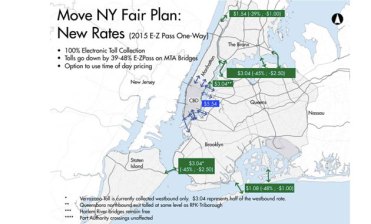Public Support for NYC Toll Reform Highest in the Suburbs
Since March, Move New York has made the case that its traffic reduction and transit funding plan can succeed in Albany. Proposing to raise car tolls in the transit-rich but congested Manhattan core while lowering them in more distant, car-dependent parts of town, Move NY seeks to avoid the political pitfalls that have sunk road pricing in the state capitol before. So how do the voters feel about this plan?
According to poll results Move NY released today, the plan is backed by a plurality of the region’s voters, 45 to 34 percent, with support stronger in the suburbs. When the plan’s benefits are explained, supporters outnumber opponents by a two-to-one margin, the group says [PDF].

The poll, conducted by Global Strategy Group over seven days in November, surveyed 1,003 registered voters in the 12-county MTA service area. It has a margin of error of 3.1 percent, with a greater margin of error in subsamples. Move NY did not share the poll’s exact phrasing or cross tabs, saying they “will have to remain proprietary.”
Move NY is proposing to add tolls on the East River bridges and across 60th Street while lowering charges on outlying MTA crossings. The plan would raise $1.44 billion annually, with three-quarters going to transit capital and operations and the remainder set aside for bridge and highway maintenance. The plan could play a critical role in filling the $15.2 billion gap in the MTA’s capital plan.
Other recent public opinion data on toll reform came from Quinnipiac in June. In that poll, 49 percent of New Yorkers were opposed and 41 percent in favor of a “toll swap” similar to the Move NY plan. (The Q poll mentioned adding East River tolls but did not mention a toll at 60th Street, a key component of the Move New York plan.)
It’s difficult to say how the Move NY proposal stacks up against the 2008 congestion pricing plan in terms of public opinion. When framed as a “charge” to drive in Manhattan below 60th Street, congestion pricing typically polled in the 30s in Quinnipiac polls from that time, but when people were asked what they thought of preventing fare hikes by implementing congestion pricing, support shot up over 60 percent.
But according to the Move NY poll, the fair toll plan now enjoys a distinct advantage: Just 22 percent of the region’s voters back the Bloomberg-era congestion pricing plan in the new poll. When told about the fair tolling concept, backers outnumbered opponents, 45-34, with support strongest among voters in Long Island (52 percent) and the northern suburbs (48 percent). After respondents received more detail about the exact toll changes to each crossing, support rose to 56 percent, with 36 percent opposed.
After voters are told more about the plan’s benefits, support increases to 62 percent with 31 percent opposed. When they are presented with criticisms of Move NY, support drops slightly to 55 percent. The survey also found that, among transportation issues, voters are most concerned about congestion, the cost of tolls, and the condition of roads and highways.
In other cities that have implemented similar road pricing policies, public support always soars after implementation, when people can see the benefits for themselves.
In January, Move NY will come out with a final version of its plan, using the poll results to tweak recommendations. For example, 63 percent of respondents said they were more likely to support the plan if it included additional express bus service, and 69 percent said the same of variable off-peak tolls. (An earlier version of the Move NY plan, developed by “Gridlock” Sam Schwartz, included variable tolls. The idea was later discarded in the name of simplicity.)
After the final report is released next month, Move NY will transition from developing its recommendations to advocating for them in Albany as Governor Andrew Cuomo and the legislature address the MTA capital plan’s $15.2 billion gap and other transportation funding questions.
Asked by a reporter today if voters and legislators would be disinterested in adding tolls to crossings that are currently free to drivers, Move NY’s Alex Matthiessen pushed back. “Our plan is an antidote to the constant raising of fares and tolls,” he said, pointing to Comptroller Tom DiNapoli’s report showing that inaction will lead to more debt, paid for by toll and fare hikes. “If you don’t come up with a revenue source, the MTA and Albany don’t have any more options.”
